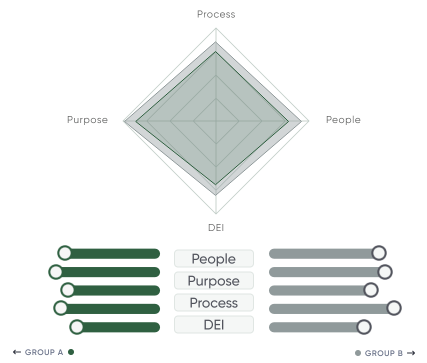3 Tools to Measure Your Company Culture

Related Insights
While taking the time to measure company culture may seem like a daunting task, with the right tools it doesn’t have to be. The powerful tools outlined below can help you establish a baseline understanding of your company’s culture, and employee net promoter score, and stay informed as your organization goes through inevitable changes. The information gained will assist you in avoiding a toxic culture and building a good company culture that becomes your competitive advantage.
1. Organizational Culture Surveys
Culture surveys might be the first tool that comes to mind when you want to measure company culture. They provide a great baseline to understand the strengths and weaknesses of your culture. One of the benefits of using a culture survey is that it provides objective measures of your culture’s strengths and weaknesses. You can then compare these benchmarks against future survey metrics to track progress. While your culture cannot be conflated to a single number or a series of numbers, these culture metrics are useful in bench-marking your organization, understanding the culture changes within your team, and monitoring progress over time. Every team experiences changes and point-in-time measures indicate what your work environment is like and whether your workplace culture is improving or not.
One aspect of an organizational culture survey or an employee engagement survey to be mindful of is that they often focus exclusively on the “people” side of the equation by assessing employee engagement, retention, communication, feedback, enps, and motivation, but neglect to include the systems and processes that allow (or restrict) work from being done.
For example, the Chapman & Co. Organizational Culture Survey was created from academic research and industry experience to provide insight into three areas critical to organizational success: interpersonal dynamics, the explicit and implicit sense of purpose and direction in the organization, and the processes that enable work to be accomplished. Within any organization, behaviors drive systems and systems drive behaviors, so it is important to choose a workplace culture survey that addresses both.
2. Focus Groups
One downside of a culture survey is that it only measures broad areas of your organization’s culture. This isn’t necessarily bad, because if they dove into every detail, the survey would be one incredibly long questionnaire. However, the strengths and weaknesses identified in the survey serve as a benchmark or starting place, which leads us to the second tool on how to assess your company culture: a focus group.
If an area of improvement surfaces from a survey, gathering a cross-section of your organization for 30 to 60 minutes can be helpful to better understand and contextualize the issue. This approach allows you to make data-driven decisions based on the metrics and insights gathered, ultimately strengthening your hr professionals’ decision-making process and more effectively improving the situation.
To do so:
Identify relevant focus groups. If a concern is limited to a specific team or location, it's best to involve only those team members in the discussion to ensure a focused and productive conversation.
Include a diverse range of employees. Challenges within an organization often have multiple facets, and team members from various departments can provide valuable insights. If your sales process is identified as an issue, engage your Sales, Marketing, Research, and Development teams, as well as any other relevant groups or individuals, to gather a comprehensive understanding of the situation.
Conduct as many focus groups as needed, but limit the size. To ensure that everyone has the opportunity to share their thoughts and be heard, keep the focus groups to a manageable size, ideally under thirty participants. This approach promotes open and honest feedback, leading to a better understanding of the employee experience.
Encourage specific examples and behaviors, rather than general opinions or hearsay. By focusing on concrete stories, you can avoid generalizations and exaggerations, and instead gather actionable information. For example, a statement like "This company punishes anyone who speaks up" is less helpful than "When I shared my thoughts during our Monday project meeting, I was told after the meeting by my manager that I need to stay focused on the agenda instead of thinking of different ways to do things." The latter provides a specific instance that can be addressed to improve the work environment and overall employee satisfaction.
Engage in empathetic listening. Actively listening to your team members allows you to facilitate more meaningful conversations. This approach encourages honest employee sentiments while making them feel valued, ultimately leading to increased buy-in when it comes to implementing initiatives to address the identified issues and build a positive company culture.
Express appreciation after each person shares. Regardless of whether you agree with their perspective or not, acknowledge that their story represents their truth. Thanking each team member for their contribution demonstrates your respect for their individual employee experience and helps foster a more open and supportive work environment.
3. Regular Check-Ins
Finally, pulse surveys and recurring one-on-one meetings with your team are a great way to measure organizational culture on an ongoing basis. Often an additional service that survey providers offer; pulse surveys allow you to monitor specific aspects of your company culture in real-time. This helps track progress toward your cultural goals and initiatives on a more frequent basis than once a year when you run a full organizational culture survey.
Recurring one-on-one meetings with your team members, not only allows you to provide honest feedback and coaching, they allow your team to do the same.
A few tips for these conversations:
- Ask open-ended questions. Generally, the more open-ended your questions are, the more detailed information you’ll receive. Often, closed-ended or leading questions serve to reinforce our perceptions instead of expanding it to understand the other’s experience of the company’s culture. Open-ended questions lead to better information and real-time feedback, which helps you lead more effectively to drive culture change.
- Practice empathetic listening. As mentioned above, this helps both in focus groups and in one-on-one meetings to ensure your most important stakeholders - your team members, feel valued.
- Follow up on themes from previous culture surveys. In addition to focus groups, regular check-ins are a great place to dive deeper into themes of a recent survey. To help employees better understand the connection between feedback themes and the company's overall objectives, consider aligning these themes with your organization's core values. Sometimes the one-on-one setting allows team members to share information that they normally wouldn’t in a group setting.
Organizational culture surveys, focus groups, pulse surveys, and individual meetings all serve as tools to help you measure company culture. Once you’ve done the work to assess your company culture, you’re better informed to reinforce what is working and change what is not.
Assessing your culture is the first step. Taking action to build a strong company culture is next. Contact us to get started today.







